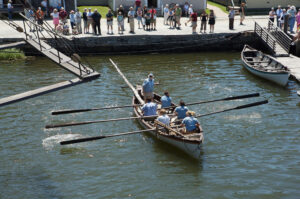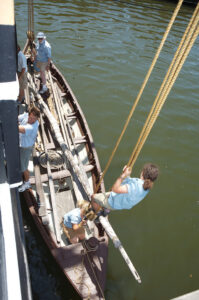 A fully equipped whaleboat is on display in the shed on Chubb’s Wharf. The building, patterned after buildings on several of New Bedford’s whaling wharves, was constructed in 1982. The whaleboat came to the Museum aboard the Charles W. Morgan in 1941. It is not known whether it was ever actually used, though it was likely built before 1920. The boat contains the gear typically carried in American whaleboats of the 1880s, and whaling tools are displayed above the boat.
A fully equipped whaleboat is on display in the shed on Chubb’s Wharf. The building, patterned after buildings on several of New Bedford’s whaling wharves, was constructed in 1982. The whaleboat came to the Museum aboard the Charles W. Morgan in 1941. It is not known whether it was ever actually used, though it was likely built before 1920. The boat contains the gear typically carried in American whaleboats of the 1880s, and whaling tools are displayed above the boat.
 The whaleboat was a beautiful craft adapted for a brutal purpose. You can see that this light, strong, double-ended boat was packed with gear for hunting the whale. Whaleships like the Charles W. Morgan carried between three and five whaleboats, hanging in davits ready to use. Each boat was operated by one of the ship’s officers and five oarsmen. About 1,200 feet of whale line were coiled in two tubs, then run around a loggerhead at the stern and forward over the oars to connect to the harpoons–which the whalemen called irons–at the bow. When the forward oarsman, usually called the boatsteerer, got the call, he stood, braced his leg in the “clumsy cleat” notch near the bow, and darted his irons into the whale. This anchored the boat to the whale. He then made his way aft to take the steering oar, and the officer came forward to kill the whale once it grew tired from pulling the boat in a “Nantucket sleighride” or diving–“sounding”– to escape. The officer used a long-shanked lance to pierce the whale’s lungs and cause it to bleed to death. Once the whale rolled over, “fin out,” in death, the boat towed the whale to the mother ship to be processed.
The whaleboat was a beautiful craft adapted for a brutal purpose. You can see that this light, strong, double-ended boat was packed with gear for hunting the whale. Whaleships like the Charles W. Morgan carried between three and five whaleboats, hanging in davits ready to use. Each boat was operated by one of the ship’s officers and five oarsmen. About 1,200 feet of whale line were coiled in two tubs, then run around a loggerhead at the stern and forward over the oars to connect to the harpoons–which the whalemen called irons–at the bow. When the forward oarsman, usually called the boatsteerer, got the call, he stood, braced his leg in the “clumsy cleat” notch near the bow, and darted his irons into the whale. This anchored the boat to the whale. He then made his way aft to take the steering oar, and the officer came forward to kill the whale once it grew tired from pulling the boat in a “Nantucket sleighride” or diving–“sounding”– to escape. The officer used a long-shanked lance to pierce the whale’s lungs and cause it to bleed to death. Once the whale rolled over, “fin out,” in death, the boat towed the whale to the mother ship to be processed.
During the warmer months the Museum’s Special Demonstration Squad rows a whaleboat to Middle Wharf to describe how whaleboats were used and demonstrate how maneuverable they are.
75 Greenmanville Ave
Mystic, CT 06355
860-572-0711
info@mysticseaport.org
Copyright © 2021 Mystic Seaport Museum
75 Greenmanville Ave
Mystic, CT 06355
860-572-0711